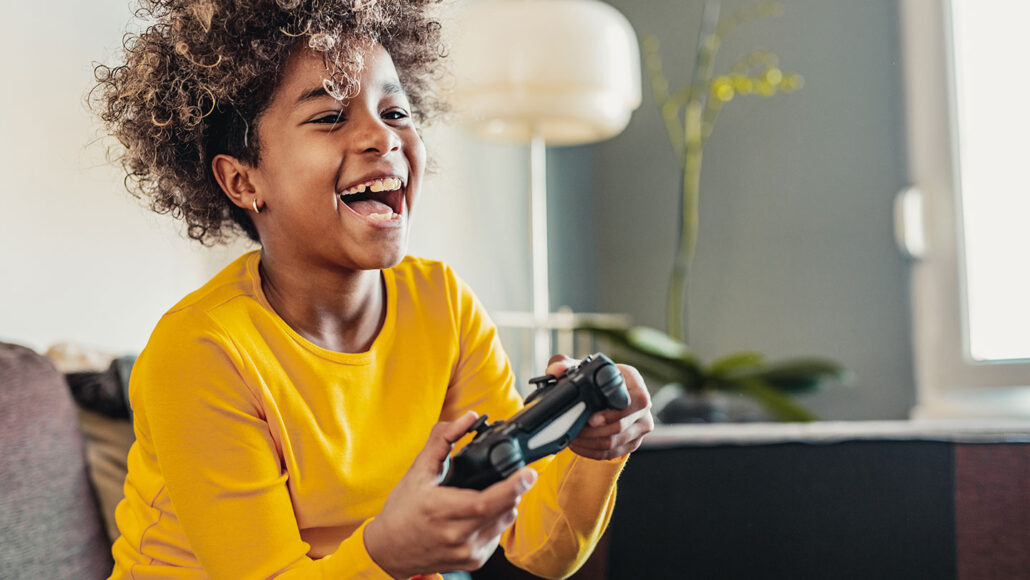Playing video games may improve your memory and attention
A study of more than 2,000 kids finds some beneficial changes in their brains and behavior

Kids who game more than 20 hours a week did better than nongamers on mental tasks requiring memory and attention.
blackCAT/E+/Getty Images Plus
Plenty of kids spend their free time playing video games. And plenty of adults — including parents — worry those games might be harmful to a child’s developing brain. But a new study finds games could offer some benefits to the mind. Video gamers performed better on two separate mental tasks than nongamers did.
The researchers shared their findings in JAMA Network Open on October 24.
Many studies have looked at brain impacts of playing video games. To date, there hasn’t been a clear answer as to their effects. Some studies suggested gaming might harm a young player’s mind. Others pointed to possible benefits. One reason for the difference? Small sample sizes, says Bader Chaarani. He is a neuroscientist at the University of Vermont in Burlington. “It’s really important,” he says, “to have as big a sample as we can get.” That means you need to test lots and lots of people.
Chaarani was part of a team that set out to study the brains of more than 2,000 kids. They came from 21 different sites across the United States. All were taking part in what’s known as the Adolescent Brain Cognitive Development (ABCD) Study. Every year, its participants — between the ages of 10 and 20 — answer a series of questions. Some deal with things like their height, weight and physical health. Others focus on a kid’s activity, mental health and more. Every other year, the scientists also perform an MRI scan of each kid’s brain.
Chaarani and his team worked with data from 2,217 children who had their brains scanned at age 9 or 10. All belonged to one of two groups. Some kids said they never play video games. This was the non-gamer group. A video-gamer group reported playing at least three hours a day. The researchers compared scans from the two groups, looking for signs that might point to differences in their cognition (ability to think and learn).
While in the MRI scanner, the kids performed tasks. One asked them to press an arrow key that matched the right or left arrow on a computer screen. But if the arrow was followed by an arrow that pointed up, the kids were supposed to not press a key. The up arrow was a signal to stop. This task tested their ability to quickly act on that stop cue.
The second task asked the kids to remember facial expressions in pictures shown on the screen. They were supposed to remember the very first expression they saw. They also had to remember the expression they had seen two faces back before any given moment. This tested what’s known as their working memory — holding onto and using short-term information.
As kids performed the tasks, the scanner recorded activity in their brains.
Gamers proved better at both tasks. Compared to non-gamers, they more often could stop themselves from clicking a key when the up arrow appeared. They also were better at remembering facial expressions.
Leveling up the brain?
Those findings matched what showed up in certain areas of the kids’ brain scans. Specifically, Chaarani says, parts of the brain “that are highly involved in working memory and attention and problem solving” were more active in gamers. That’s not surprising. “Games require fast-paced processing of many [types of] information within a very short amount of time.” And, he adds, “they require problem solving, [and] a lot of visual attention.”
Brain areas involved in hand-eye coordination were less active in gamers than non-gamers. Chaarani says that’s likely due to practice. It’s like using a muscle. Someone who goes to the gym, he notes, “can lift the same weight using little effort [compared to] someone who goes to the gym for the first time.” Gamers’ brains seem to have become stronger in this area. They didn’t need to work as hard for the kids’ hands to respond to the images viewed on the screen.
Do gamers have an advantage because the tasks used screens and keyboards, just as video games do? The researchers don’t think so. But, Chaarani says, “that’s something we can verify by looking at other cognitive tasks that don’t involve eye-finger coordination.”
Fran Blumberg works at Fordham University in New York City. There, she studies children’s attention and problem-solving skills. As she points out, this study “is correlational.” That means we don’t know if playing games caused the effects that were seen. However, she adds, the study does appear to show that gamers perform better on certain tasks than non-gamers. And those match up with differences seen in their brain scans. The big question, she asks, is why. “We still need more studies to understand why we see the difference in pictures of the brain between these two groups of children.”
The results might please gamers. Still, Chaarani urges caution. “Don’t jump to conclusions,” he says. “Many media sources have been interpreting [the results to mean] video gaming is good for you. We’re not saying that.” Observed brain changes could come at the expense of other brain functions. This study was a first look at this group of kids from the ABCD study. Chaarani plans to see whether and how their skills — and brains — may change over time.







